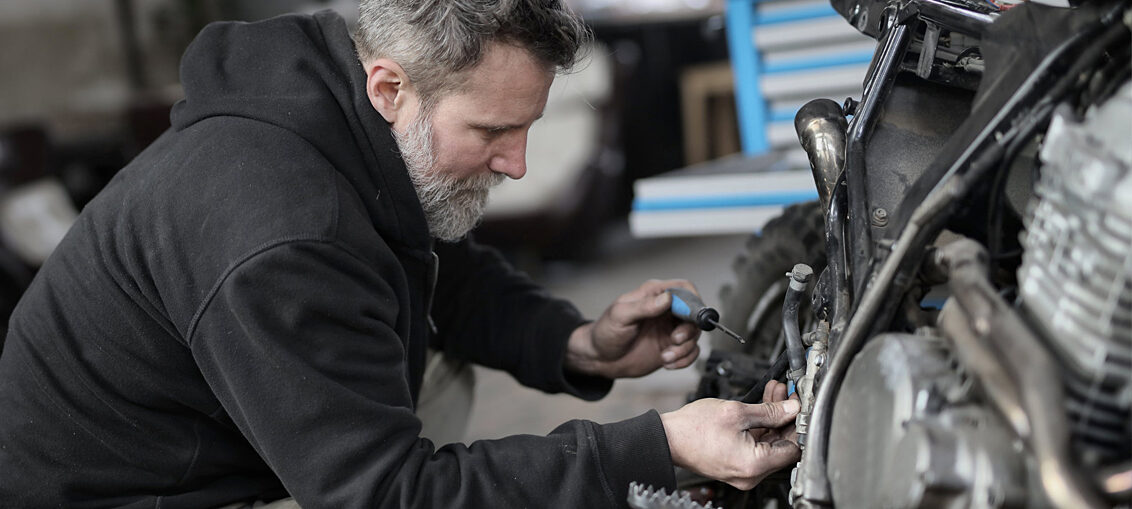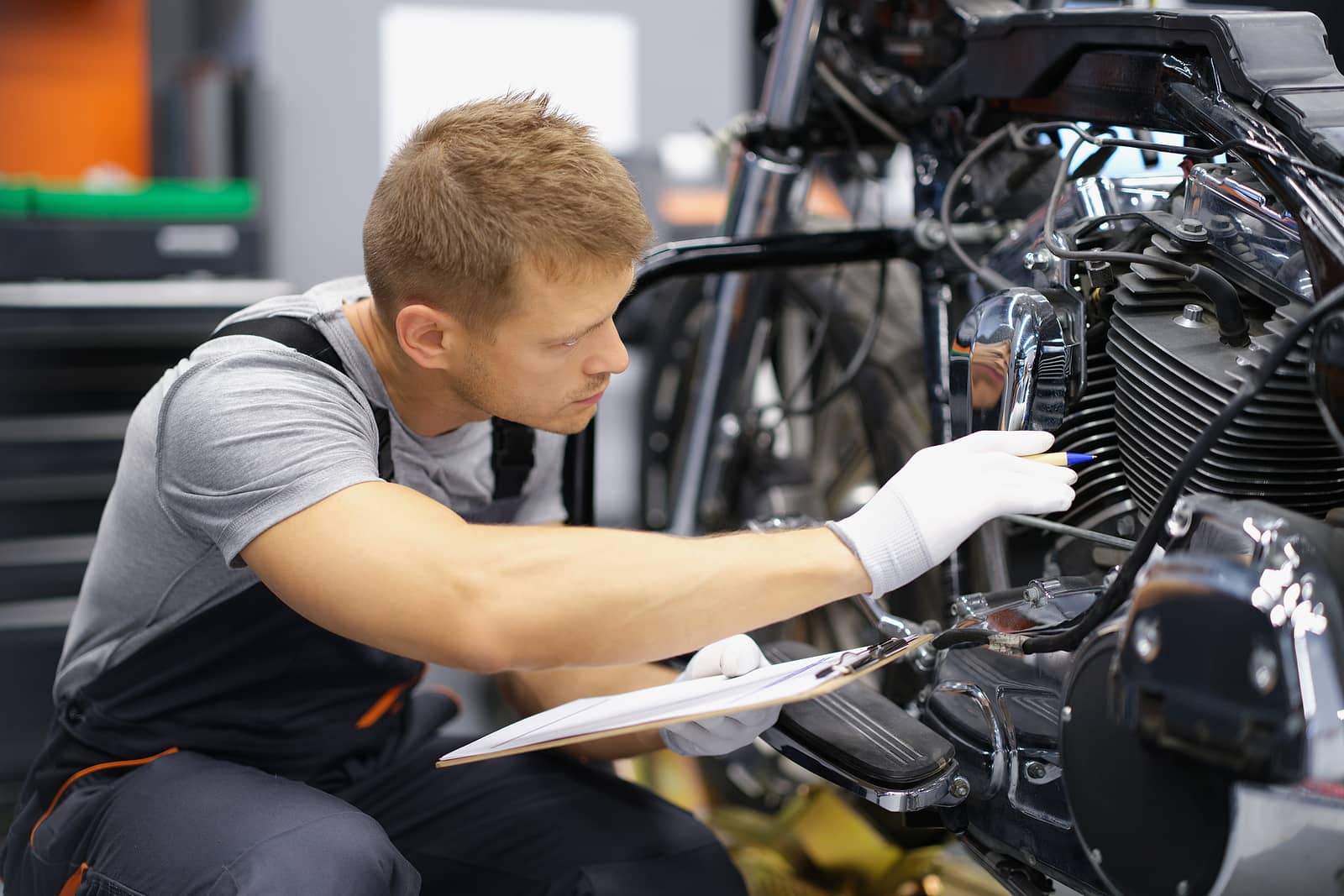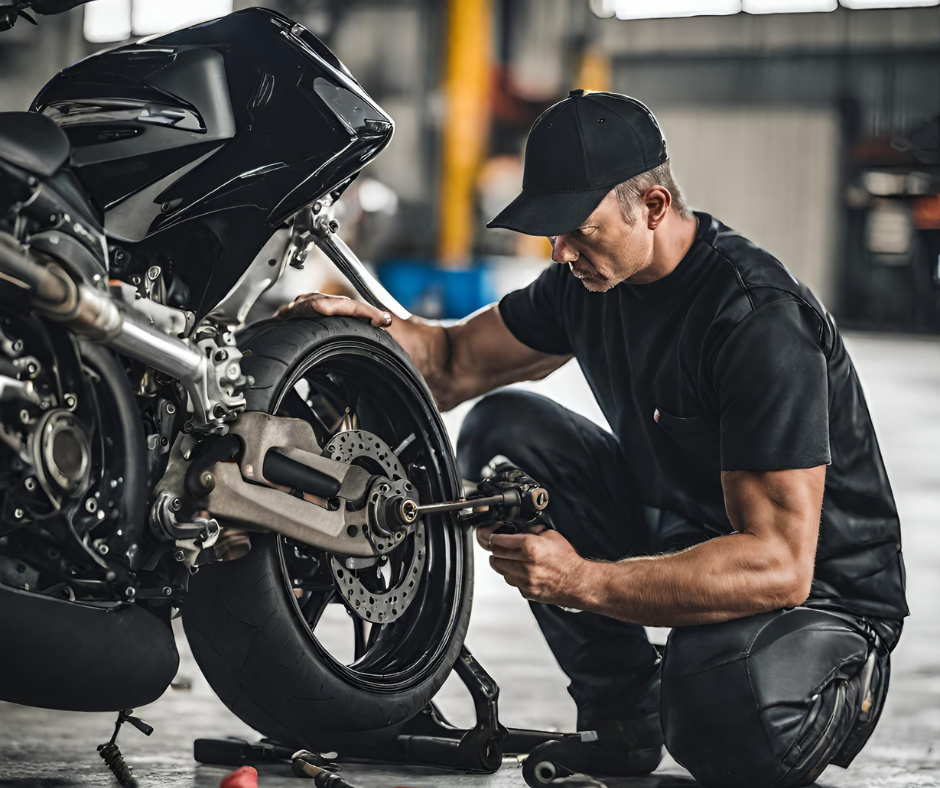


I. Introduction
A. The Importance of Regular Motorcycle Inspections
Regular motorcycle inspections are an essential aspect of motorcycle ownership, ensuring the safety, performance, and longevity of your beloved machine. These proactive checks help identify and address potential issues before they escalate into costly breakdowns, accidents, or even injuries. A well-maintained motorcycle not only enhances your riding experience but also protects your investment and the well-being of yourself and others on the road.
B. Types of Motorcycle Inspections
To ensure your motorcycle remains in top condition, it’s crucial to conduct various types of inspections at different intervals. These range from quick pre-ride checks to more in-depth seasonal inspections:
-
Pre-ride inspections: These brief checks should be performed before every ride to identify any immediate safety concerns. They typically involve inspecting tires, brakes, lights, and fluid levels.
-
Daily inspections: A more thorough examination of your motorcycle’s overall health, daily inspections should include checking fluid levels, chain condition, and the tightness of nuts and bolts.
-
Seasonal inspections: As the seasons change and riding conditions vary, seasonal inspections allow you to prepare your motorcycle accordingly. Spring inspections typically involve checking for winter-related damage, while fall inspections focus on preparing for colder months.
-
Pre-storage inspections: If you plan to store your motorcycle for an extended period, a comprehensive pre-storage inspection is crucial. This involves cleaning, lubricating, and protecting various components to prevent damage during downtime.
II. Essential Tools and Equipment for Motorcycle Inspections
To conduct effective motorcycle inspections, you’ll need to gather the necessary tools and equipment. A well-stocked toolbox should include basic tools like screwdrivers, wrenches, pliers, and a tire pressure gauge. Additionally, a flashlight is essential for inspecting dark areas, and a first aid kit should be readily available in case of emergencies. For more in-depth inspections, consider investing in diagnostic tools such as a multimeter, a compression tester, and a leak detection kit. A motorcycle stand or lift can also be helpful for safely raising the motorcycle during inspections.
III. Pre-ride Inspections: A Quick Check for Safety
Pre-ride inspections are crucial for ensuring a safe and enjoyable ride. These quick checks should take no more than a few minutes and can prevent potential accidents and breakdowns.
-
Tire Inspection: Tires are the only points of contact between your motorcycle and the road, making their condition paramount. Check tire pressure regularly, ensuring it meets the manufacturer’s specifications. Inspect tire tread depth for adequate wear and examine tires for any cuts, cracks, or bulges that could indicate damage.
-
Brake Inspection: Properly functioning brakes are essential for stopping safely. Check brake fluid levels and ensure they are within the recommended range. Inspect brake pads for wear and replace them if necessary. Test the brakes to ensure they are functioning properly and providing adequate stopping power.
-
Lights and Electrical System: Ensure all lights, including headlights, taillights, brake lights, and turn signals, are working correctly. Check the battery voltage and connections for any corrosion or damage. Inspect wiring for any fraying or exposed wires that could cause electrical shorts or malfunctions.
IV. Daily Inspections: Ensuring Ongoing Motorcycle Health
Daily inspections allow you to monitor your motorcycle’s overall health and identify potential issues early on. These checks should be incorporated into your regular riding routine.
-
Fluid Levels: Regularly check engine oil level and top off if necessary. Inspect coolant level and add coolant if needed. Check brake fluid levels and ensure they are within the recommended range. Maintaining proper fluid levels is crucial for engine performance, cooling, and braking efficiency.
-
Chain Inspection and Maintenance: A properly maintained chain ensures smooth power transfer and reduces wear on sprockets. Check chain tension and adjust if necessary. Lubricate the chain with a suitable lubricant to prevent rust and corrosion. Inspect the chain for signs of wear or damage, such as excessive stretching, loose links, or rust.
-
Nuts and Bolts: Loose nuts and bolts can cause components to vibrate and potentially come loose, leading to safety hazards. Regularly check the tightness of all nuts and bolts, especially those securing critical components like the engine, wheels, and suspension.

V. Seasonal Inspections: Preparing for Changing Conditions
As the seasons change and riding conditions vary, it’s important to adapt your motorcycle inspection routine accordingly. Seasonal inspections allow you to prepare your motorcycle for the specific challenges of each season.
-
Spring Inspection: After winter storage, a thorough spring inspection is crucial to identify any issues that may have arisen during the off-season. Check for corrosion or damage caused by humidity or extreme temperatures. Ensure all fluids are in good condition and at the appropriate levels. Inspect tires, brakes, lights, and electrical components for any signs of wear or damage.
-
Fall Inspection: As the weather cools down, prepare your motorcycle for the
VI. Pre-storage Inspections: Protecting Your Motorcycle During Downtime
If you plan to store your motorcycle for an extended period, a comprehensive pre-storage inspection is crucial to prevent damage and ensure a smooth transition back to riding when the time comes.
-
Cleaning and Preparation: Thoroughly wash and dry the motorcycle to remove dirt, debris, and potential corrosion-causing elements. A clean motorcycle is less susceptible to rust and other forms of deterioration during storage. Wax or coat the motorcycle’s paint and metal components with a suitable product to protect them from moisture and rust. Additionally, lubricate moving parts like the chain, cables, and levers to prevent seizing or corrosion during storage.
-
Fuel and Fluid Management: A full fuel tank helps prevent condensation and corrosion inside the tank. Consider adding a fuel stabilizer to further protect the fuel system during storage. Drain and replace old engine oil and filter to prevent contaminants from settling and potentially harming the engine during storage. Adjust tire pressure slightly higher than the recommended riding pressure to account for potential pressure loss over time.

VII. Consulting Your Owner’s Manual
While this guide provides a general framework for motorcycle inspections, it’s crucial to consult your motorcycle’s owner’s manual for specific recommendations and maintenance procedures. The manual will contain detailed information about your motorcycle’s specific needs, including fluid capacities, recommended maintenance intervals, and proper adjustment specifications.
VIII. Conclusion: Building a Habit of Motorcycle Inspection
By incorporating regular motorcycle inspections into your routine, you can ensure the safety, performance, and longevity of your motorcycle. These inspections empower you to take control of your motorcycle’s health, allowing you to identify and address potential issues before they escalate into major problems. Remember, a few minutes spent on inspections can save you time, money, and potentially prevent accidents on the road. So, make motorcycle inspections a habit and enjoy the peace of mind and confidence that comes with knowing your motorcycle is in top condition.
IX. Additional Tips for Motorcycle Inspection Success
Here are some additional tips to ensure your motorcycle inspections are successful:
- Develop a checklist: Create a personalized checklist tailored to your motorcycle and inspection frequency. This will help you stay organized and ensure you don’t miss any crucial checks.
- Take notes: During inspections, make notes of any issues you identify. This will help you track potential problems and prioritize repairs or maintenance needs.
- Don’t hesitate to seek professional help: If you’re unsure about any aspect of motorcycle inspection or maintenance, don’t hesitate to consult a qualified mechanic. They can provide expert advice and assistance with more complex tasks.
By following these guidelines and fostering a proactive approach to motorcycle inspections, you can ensure that your motorcycle is always ready to deliver a thrilling and safe riding experience. So, grab your tools, get down on your knees, and start inspecting your motorcycle for a smoother, safer, and more enjoyable ride. Colder months by checking tire pressure, lights, and electrical components to ensure optimal performance in lower temperatures. Consider adding antifreeze to the coolant system to prevent freezing and potential engine damage. Additionally, lubricate moving parts to ensure smooth operation in cooler temperatures.
-
Leave a Reply